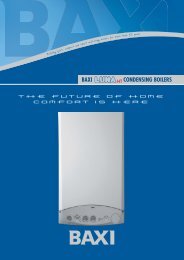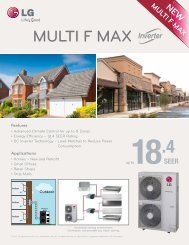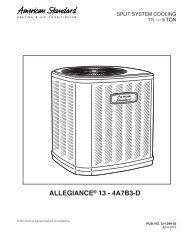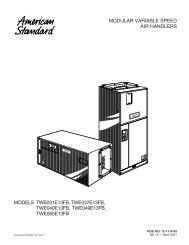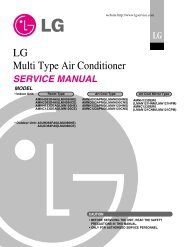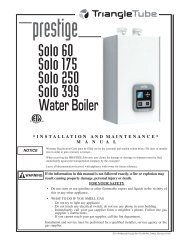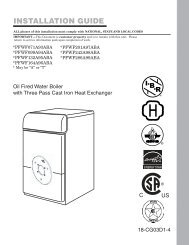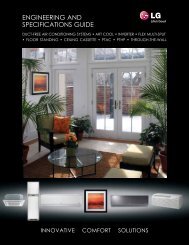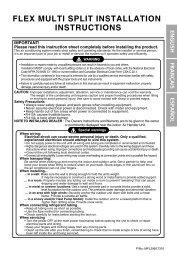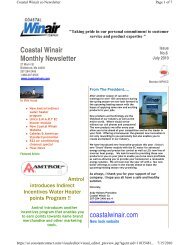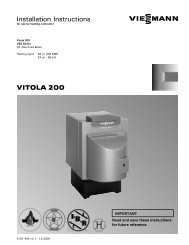INSTALLATION OPERATION MAINTENANCE - Coastal Winair
INSTALLATION OPERATION MAINTENANCE - Coastal Winair
INSTALLATION OPERATION MAINTENANCE - Coastal Winair
Create successful ePaper yourself
Turn your PDF publications into a flip-book with our unique Google optimized e-Paper software.
Trouble ShootingZone Temperature Sensor (ZTS) TestNote: These procedures are not for programmableor digital models and are conducted with the ZoneSensor Module electrically removed from thesystem.Test 1Zone Temperature Thermistor (ZTEMP)This component is tested by measuring the resistance betweenterminals 1 and 2 on the Zone Temperature Sensor.Below are some typical indoor temperatures, and correspondingresistive values.Test 2Cooling Set Point (CSP) and Heating Set Point (HSP)ZoneTem peratureNom inal ZTEMPResistance50 F° 10.0 C 19.9 K-Ohms55 F 12.8 C 17.47 K-Ohms60 F 15.6 C 15.3 K-Ohms65 F 18.3 C 13.49 K-Ohms70 F 21.1 C 11.9 K-Ohms75 F 23.9 C 10.50 K-Ohms80 F 26.7 C 9.3 K-Ohms85 F 29.4 C 8.25 K-Ohms90 F 32.2 C 7.3 K-OhmsThe resistance of these potentiometers are measured betweenthe following ZSM terminals. Refer to the chart abovefor approximate resistances at the given setpoints.Cool SP = Terminals 2 and 3Range = 100 to 900 Ohms approximateHeat SP = Terminals 2 and 5Range = 100 to 900 Ohms approximateTest 3System Mode and Fan SelectionThe combined resistance of the Mode selection switch andthe Fan selection switch can be measured between terminals2 and 4 on the Zone Sensor. The possible switch combinationsare listed below with their corresponding resistancevalues.Test 4LED Indicator Test, (SYS ON, HEAT, COOL & SERVICE)Method 1Testing the LED using a meter with diode test function. Testboth forward and reverse bias. Forward bias should measurea voltage drop of 1.5 to 2.5 volts, depending on yourmeter. Reverse bias will show an Over Load, or open circuitindication if LED is functional.Method 2Testing the LED with an analog Ohmmeter. Connect Ohmmeteracross LED in one direction, then reverse the leadsfor the opposite direction. The LED should have at least 100times more resistance in reverse direction, as comparedwith the forward direction. If high resistance in both directions,LED is open. If low in both directions, LED is shorted.Method 3To test LED’s with ZSM connected to unit, test voltages atLED terminals on ZSM. A measurement of 32 VDC, acrossan unlit LED, means the LED has failed.Relative Humidity Sensor TestThis component is measured by measuring the mA outputsignal on the Relative Humidity Sensor. Verify accuracy ofthe sensor annually. If the output reading is 0 mA, first verifythat power is applied to the sensor. A reading of 4 mAcorresponds to 0% RH and 20 mA corresponds to 100%RH.% RH mA30 8.840 10.450 12.060 13.670 15.280 16.8Note: Measurements should be made from LEDcommon (ZSM terminal 6 to respective LEDterminal). Refer to the Zone Sensor Module (ZSM)Terminal Identification table at the beginning of thissection.Programmable & Digital Zone Sensor TestTesting serial communication voltage1. Verify 24 VAC is present between terminals J6-14 & J6-11.2. Disconnect wires from J6-11 and J6-12. Measure the voltagebetween J6-11 and J6-12, should be about 32 VDC.3. Reconnect wires to terminals J6-11 and J6-12. Measurevoltage again between J6-11 and J6-12, voltage shouldflash high and low every 0.5 seconds. The voltage on thelow end will measure about 19 VDC, while the voltage onthe high end will measure from approximately 24 to 38VDC.4. Verify all modes of operation, by running the unit throughall of the steps in the “Test Modes” section discussed in“Unit Start-Up”.5. After verifying proper unit operation, exit the test mode.Turn the fan on continuously at the ZSM, by pressing thebutton with the fan symbol. If the fan comes on and runscontinuously, the ZSM is good. If you are not able to turnthe fan on, the ZSM is defective.ReliaTel Refrigeration Module (RTRM) Default ChartIf the RTCI loses input from the building management system,the RTRM will control in the default mode after approximately15 minutes. If the RTRM loses the Heating and Coolingsetpoint input, the RTRM will control in the default modeinstantaneously. The temperature sensing thermistor in theZone Sensor Module is the only component required for the“Default Mode” to operate.43



